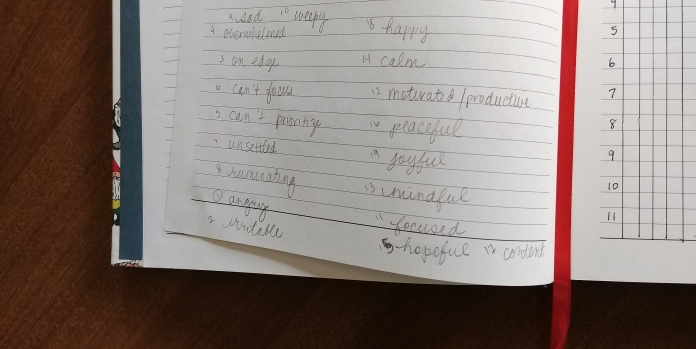This past Sunday afternoon, I finally sat down with my thirteen year-old to create a mood tracker bullet-journal style.
It was an activity months in the making. Once I expressed an interest, she would bring it up from time to time, asking me when we’d actually sit down and bu-jo together, as she says. Eventually the questioning took on an annoyed tone as she began to wonder when and if it would actually happen.
Initially, it really was just a matter of scheduling. When did we actually have an afternoon off to spend together with markers and blank books? Looking back, I now realize there were other factors at play – none of which had to do with this lovely little being who wanted to spend time with me on the cusp of not wanting to spend time with me. So I shoved those aside, or at least down enough for the day, so she wouldn’t begin to take things personally. Those factors, however, say a lot about where I’m at right now.
First, I was unsure where to start. I’ve never bullet journaled before and haven’t sketched or doodled just for the joy of it in decades. Ain’t no mom got time for that. And I certainly couldn’t let go enough to enjoy it. If I was going to do this, it had to be done right and in an aesthetically pleasing manner. And if I was going to invest time and blank page space, the information I collected had to be useful. I wanted facts and indicators I could bring back to my practitioners to prove my case and plan of treatment. When I finally sank into the couch with her, I realized I hadn’t started because I didn’t know which layout to use to best serve my needs. Bless her thirteen year-old technologically saavy heart, she launched you-tube and pinterest searches in conjunction, showing me what she found.
Of course, I had to create my own hybrid version of a few I’d found. I also think I let go of the idea of perfection for this month, figuring I won’t know what exactly works for me until I actually interface with it and can adjust as needed going forward.
After I created a grid with just over two weeks’ worth of dates running down its side, I set about choosing mood indicators to list across the top. Five manner of emojis was not going to do it for me. I was seeking language to differentiate blah from ennh to my physician. I needed specific descriptors. But choosing those descriptors was another story. I broke out a pencil and began a list on a separate page.

Jennifer Butler Basile
In a very short time, I realized how many more negative descriptors I had than positive ones. Why did I have so many words appropriate for shitty ways of being than good ones? The easy answer is that I’ve had lots of practice, apparently, with low moods. The more difficult answer I’m still unpacking is how my mind tends to the negative. Is my brain wired to a pessimistic program? Or is it stuck in a rutted road of negativity since it’s been travelling in that direction for so long? Does it need a reprogram? Is that possible?
My final list, which I’m still not completely sold should be absolutely final, has one more negative descriptor than positive, but I forced myself to beef up the positive side so it wasn’t totally lopsided. I also find my negative words so much more specific, evocative. I find the positive descriptors more vague and general. Again, I’ve been living in the land of low moods so apparently I know them better.
Writing such a raw, vulnerable list with my daughter at my elbow was unsettling to say the least. The fact that she aided my progress both makes me proud that she’s so creative; that she’s so willing to accept me as I am. It also makes me hopeful that perhaps an idea like tracking moods will become so commonplace to her generation that dialogue surrounding mental health will be like breathing air. But I’m also terrified. I’m afraid she’ll see what a broken person I am. And not due to some ‘I’m so strong and perfect’ façade I’m trying to portray. Just, I don’t know, that I struggle. As in, how can I take care of her if I haven’t perfected how to care for myself? But even as I write that, I know that’s all a part of being human and she’ll figure it out sooner or later no matter what.

Jennifer Butler Basile
The reason I wanted a mood tracker was to turn a highly subjective entity – moods and feelings – into a quantifiable collection of data. For some reason, I think I actually expected that by putting it into a grid would miraculously turn it from one thing to the other. Perhaps I knew that was wishful thinking and why I postponed it for so long. I also realized how much my procrastination is fueled by my perfectionism. I also learned that, whatever its origin, I need to check my negativity so that it doesn’t rule my life.
So before I’ve even collected more than a day’s worth of data, my mood tracker has already proved to be an illustrative tool – in ways I may have never even imagined.
This is interesting. I never heard of this and it seems like it will be very useful in many ways. I hope you can give us a summary after a few weeks.
LikeLiked by 1 person
Excellent suggestion! That will keep me accountable 😂
LikeLiked by 1 person